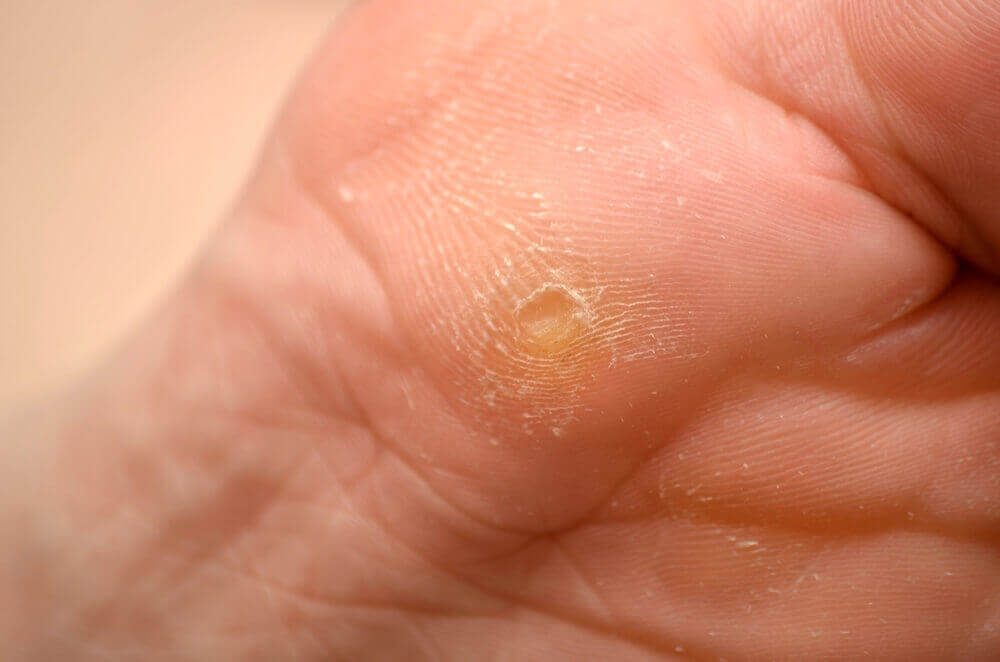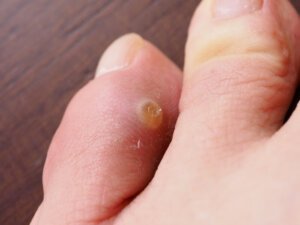
Ever wondered, “How do I get rid of a corn?”
What are corns?
Before we can answer, 'How do I get rid of a corn', we need to tell you a little bit about what they actually are.
Corns are thickened areas of the skin with a hard, central core that form in response to friction and pressure. They can occur anywhere on the foot but are commonly on pressure points such as the tops and ends of toes, and the balls of the feet.
The most common type of corns are often referred to as ‘hard corns’ due to the texture of the skin. However, they can also form between two toes, when they rub together and cause the skin to thicken. These are often called ‘soft corns’ due to the high moisture levels in the skin in these areas.
There are also some corns which form on other areas, such as the arch of the foot. There are called ‘seed corns’ and aren’t necessarily true corns. No-one is really sure how or why these form but exfoliating and moisturising can help to reduce them.

What does a corn look like?
Corns are normally circular but can be crescent or linear shaped depending on the types of forces involved.
There are other skin lesions that can look very similar to a corn but have very different causes. A good example is verruca, so getting the right diagnosis is key to treatment. Each type of skin lesion will need a different treatment to resolve them. We use our skills and experience as Podiatrists to examine skin lesions, often using our Dermatoscope to help. Then we can put the appropriate treatment plan in place.
What causes a corn?
As we have described above, corns form as a reaction to friction and pressure. If corns appear on the sole of the foot, then this is usually due to the foot shape, structure and frictional forces going through that foot during walking.
Corns on the ends of toes can form due to hammer toe deformities putting that part of the toe into contact with the ground. The very ends of our toes are not designed to be walked on!
Those that form on the tops of toes are almost always caused by footwear. The only things in contact with this part of the foot to cause the pressure is shoes!
How do you treat them? How can I get rid of a corn?
Podiatrists deal with corns every single day! Having corns treated professionally is the safest way to get rid of a corn. Initial treatment involves gently removing the corn itself with a scalpel, taking away the core of hard skin that has formed. However, it is important to identify the cause of the pressure to stop the corns re-forming.
Ongoing preventative treatment might involve
- footwear advice,
- cushioning offloading insoles for the soles of the feet,
- silicone devices to protect hammer toes,
- in the case of soft corns between toes, a bespoke moulded silicone wedge to gently separate the digits.
Removing the cause of the corn is the best way to prevent it re-forming.
Other than changing footwear or wearing cushioning insoles, we don’t recommend treating corns yourself at home. Many treatments you can buy over the counter contain acids designed to soften the skin. These can cause damage if they come into contact with the surrounding healthy skin.
If you are suffering with corns, or think you might be, then give us a call or book online and let us help you find out how to get rid of your corns and walk pain-free.
If you want to know more about corns and calluses, then this article from DermnetNZ is fantastic! Read it here
Anna Conway
BSc (Hons), MCPod, SRCh, PGcert Podiatry
Owner, Lead Podiatrist

